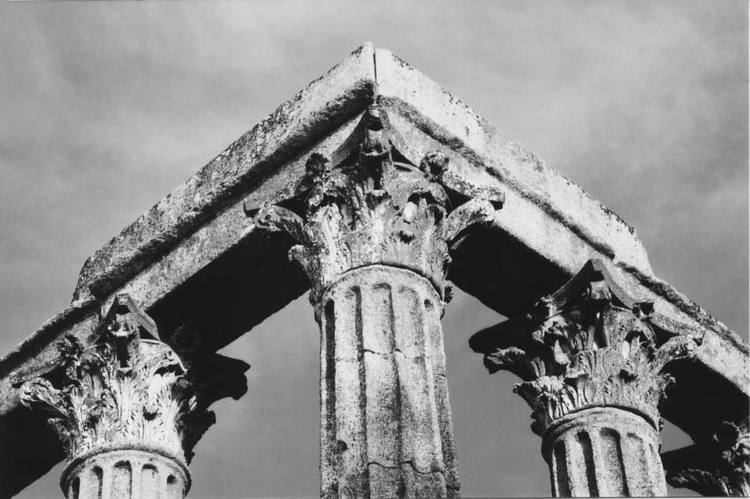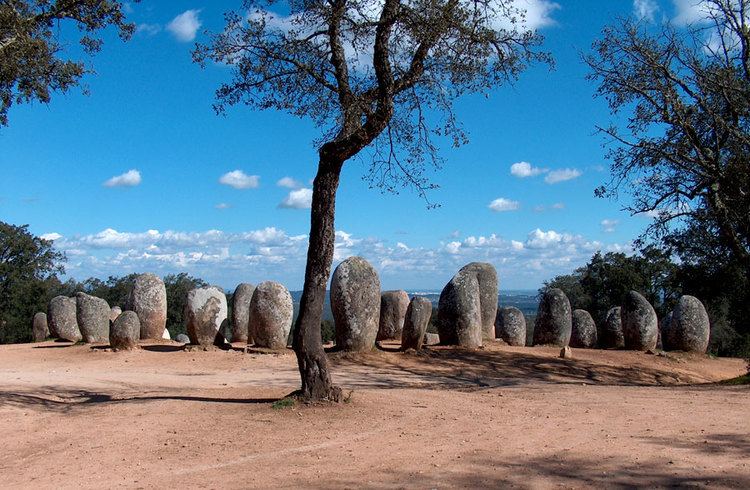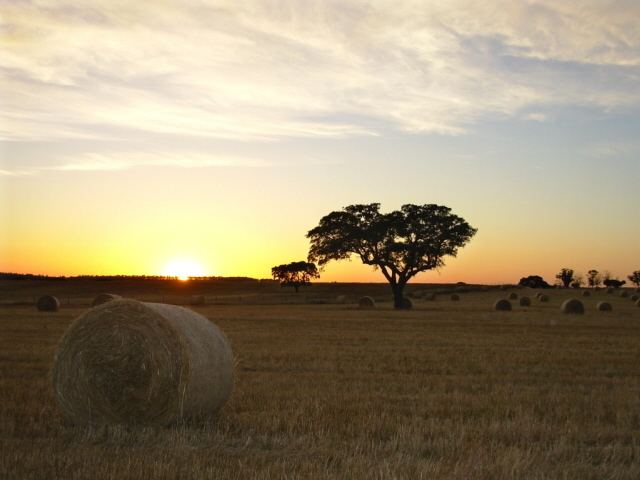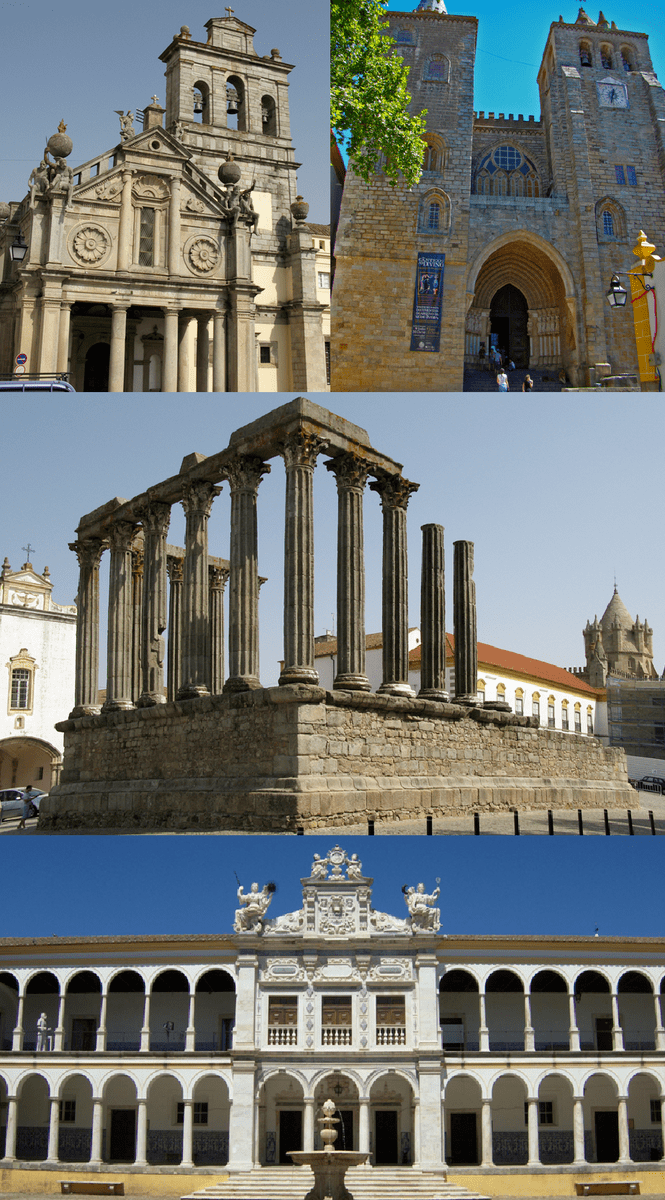Country Portugal Area 1,307.08 km2 District Évora | ||
 | ||
Points of interest Capela dos Ossos, Roman Temple of Évora, Almendres Cromlech, Igreja de São Francisco | ||
Evora portugal travel channel
Évora ([ˈɛvuɾɐ]) is a city and a municipality in Portugal. The population in 2011 was 56,596, in an area of 1307.08 km². It is the seat of the Évora District and capital of the Alentejo region. The present Mayor is Carlos Pinto de Sá of the CDU coalition. The municipal holiday is 29 June.
Contents
- Evora portugal travel channel
- Map of vora
- Early history
- Roman rule
- Moorish rule
- Reconquest
- Manueline favour
- Recent history
- Physical geography
- Climate
- Human geography
- International relations
- Economy
- Transport
- Prehistoric
- Civic
- Religious
- References
Map of Évora
Due to its well-preserved old town centre, still partially enclosed by medieval walls, and a large number of monuments dating from various historical periods, including a Roman Temple, Évora is a UNESCO World Heritage Site. It is also a member of the Most Ancient European Towns Network.

Évora is ranked number two in the Portuguese most livable cities survey of living conditions published yearly by Expresso. It was ranked first in a study concerning competitiveness of the 18 Portuguese district capitals, according to a 2006 study made by Minho University economic researchers.
Early history

Évora has a history dating back more than five millennia.

It was known as Ebora by the Celtici, a tribal confederacy, south of the Lusitanians (and of Tagus river), who made the town their regional capital.
The etymological origin of the name Ebora is from the ancient Celtic word ebora/ebura, plural genitive of the word eburos (yew), name of a species of tree, so its name means "of the yew trees." The city of York, in northern England, at the time of the Roman Empire, was called Eboracum/Eburacum, named after the ancient Celtic place name *Eborakon (Place of Yew Trees), so the old name of York is etymologically related to the city of Évora. Other two hypothesis of the origin of the name Évora is that the Romans had extensive gold mining in Portugal, and the name may be derived from that oro, aurum, (gold) and also may be named after ivory workers, but these two hypotheses are much less likely than the first one, because the name Évora has no relation with gold or with ivory in ancient Celtic, Latin or Portuguese languages or other languages, there is no etymological ground for these two hypotheses. It may have been capital of the kingdom of Astolpas.
Roman rule
The Romans conquered the town in 57 BC and expanded it into a walled town. Vestiges from this period (city walls and ruins of Roman baths) still remain. Julius Caesar called it Liberalitas Julia (Julian generosity). The city grew in importance because it lay at the junction of several important routes. During his travels through Gaul and Lusitania, Pliny the Elder also visited this town and mentioned it in his book Naturalis Historia as Ebora Cerealis, because of its many surrounding wheat fields. In those days, Évora became a flourishing city. Its high rank among municipalities in Roman Hispania is clearly shown by many inscriptions and coins. The monumental Corinthian temple in the centre of the town dates from the first century and was probably erected in honour of emperor Augustus. In the fourth century, the town had already a bishop, named Quintianus.
During the barbarian invasions, Évora came under the rule of the Visigothic king Leovigild in 584. The town was later raised to the status of a cathedral city. Nevertheless, this was a time of decline and very few artifacts from this period remain.
Moorish rule
In 715, the city was conquered by the Moors under Tariq ibn-Ziyad who called it Yaburah يابرة. During the Moorish rule (715–1165), the town, part of the Taifa of Badajoz, slowly began to prosper again and developed into an agricultural center with a fortress and a mosque. The present character of the city is evidence of the Moorish influence. During that time, several notables hailed from Evora, including Abd al-Majid ibn Abdun Al-Yaburi عبد المجيد بن عبدون اليابري, a poet whose diwan still survives to this day.
Reconquest
Évora was wrested from the Moors through a surprise attack by Gerald the Fearless (Geraldo Sem Pavor) in September 1165. The town came under the rule of the Portuguese king Afonso I in 1166. It then flourished as one of the most dynamic cities in the Kingdom of Portugal during the Middle Ages, especially in the 15th century. The court of the first and second dynasties resided here for long periods, constructing palaces, monuments and religious buildings. Évora became the scene for many royal weddings and a site where many important decisions were made.
Manueline favour
Particularly thriving during the Avis Dynasty (1385–1580), especially under the reign of Manuel I and John III, Évora became a major centre for the humanities (André de Resende - buried in the cathedral) and artists, such as the sculptor Nicolau Chanterene; the painters Cristóvão de Figueiredo and Gregório Lopes; the composers Manuel Cardoso and Duarte Lobo; the chronicler Duarte Galvão; and the father of Portuguese drama, Gil Vicente.
Évora also held a large part of the slave population of Portugal. Nicolas Clenard, a Flemish tutor at the Portuguese court, exclaimed in 1535 that "In Évora, it was as if I had been carried off to a city in hell: everywhere I only meet blacks."
The city became the seat of an archbishopric in 1540. The university was founded by the Jesuits in 1559, and it was here that great European Masters such as the Flemish humanists Nicolaus Clenardus (Nicolaas Cleynaerts) (1493–1542), Johannes Vasaeus (Jan Was) (1511–1561) and the theologian Luis de Molina passed on their knowledge. In the 18th century, the Jesuits, who had spread intellectual and religious enlightenment since the 16th century, were expelled from Portugal, the university was closed in 1759 by the Marquis of Pombal, and Évora went into decline. The university was only reopened in 1973.
Recent history
The Battle of Évora was fought on 29 July 1808 during the Peninsular War. An outnumbered Portuguese-Spanish force of 2,500, assisted by poorly armed peasant militiamen, tried to stop a French-Spanish division commanded by Louis Henri Loison but it was routed. Led by the hated Loison, known as Maneta or One-Hand, the French went on to storm the town which was defended by soldiers, militiamen and armed townsmen. Breaking into the town, the attackers slaughtered combatants and non-combatants alike before thoroughly pillaging the place. The French inflicted as many as 8,000 casualties while suffering only 290 of their own.
In 1834, Évora was the site of the surrender of the forces of King Miguel I, which marked the end of the Liberal Wars. The many monuments erected by major artists of each period now testify to Évora's lively cultural and rich artistic and historical heritage. The variety of architectural styles (Romanesque, Gothic, Manueline, Renaissance, Baroque), the palaces and the picturesque labyrinth of squares and narrow streets of the city centre are all part of the rich heritage of this museum-city.
Physical geography
Évora (altitude 300 m) is situated in Alentejo, a large region of wide plains on the south of Portugal, bordered on the North by the Tagus River and on the South by the region of Algarve. The city is 140 km (87 mi) from the capital city Lisbon, and 80 km (50 mi) from Badajoz at the Spanish border. It is the chief city of the region. The seat of the municipality is the city of Évora, composed by the civil parishes of Évora (São Mamede, Sé, São Pedro e Santo Antão) in the historical centre and the urban parishes of Bacelo e Senhora da Saúde and Malagueira e Horta das Figueiras outside the ancient city walls where most of the population in fact reside. The remaining civil parishes in the municipality are rural or suburban and do not form part of the city for statistic purposes. The city's historical centre has about 4,000 buildings and an area of 1.05 km2 (0.41 sq mi).
Climate
Évora has a hot-summer mediterranean climate. As typical of the interior Alentejo, Évora is prone to severe heat extremes with an all-time record of 46 °C (115 °F). However, the average summer high usually is around 30 °C (86 °F), which is significantly less severe heat than being found in nearby Andalusia, Spain. This is due to low-scale maritime effects due to the relative proximity to the Atlantic Ocean, which also causes seasonal lag predominantly during the warmer period, with night-time temperatures being milder in September than June as well as in October compared with May. Frosts in winter are frequent but not usually severe, snow falling only twice a decade. Day-time temperatures throughout winter most often staying below 10 °C (50 °F).
Human geography
Évora is a pleasant medium-sized city and has numerous monuments. Due to its long history, monuments and buildings are its main attraction to outsiders. However, there are numerous "Festas Populares" celebrating saints, holidays, "Feiras" (fairs) and cultural events (such as televised musical presentations) sponsored by the municipality and other organizations
The municipality consists of the following 12 civil parishes:
International relations
Évora is twinned with:
Évora is also part of the Most Ancient European Towns Network.
Economy
Évora is the chief city of the Alentejo region, and plays a role as an important agricultural and services center. It is home to several institutions with great importance for the region, like the state-run University of Évora and district hospital. Évora has tried to develop the aerospace sector, and has been chosen to host the Portuguese Aeronautical Cluster after Brazilian aircraft manufacturer giant Embraer decided to establish in the city two factories (one of metallic structures and other of composite structures) for the production of aircraft parts along with its European Engineering Center. The city's aeronautical park, which includes an aerodrome, is about to receive a number of other investments related to the aeronautical industry, amongst which the most noteworthy investments are the ones of Lauak and Mecachrome.
Évora, as well as the surrounding area, has many hotels, bed-and-breakfasts and various styles of accommodation.
Transport
Évora can be reached by bus or train, with the construction of a high speed train link to Lisbon and Madrid is planned.
There is a small airfield, the Évora Municipal Airport, currently without commercial airline service. The closest major airports are: Beja, Lisbon, Faro and Badajoz.
Prehistoric
Civic
The city of Évora is marked by the historic square in the Praça do Geraldo, where King Duarte constructed the Estaus Palace. The square is marked by the Henriquina fountain, dating to 1570, that includes eight jets symbolizing the eight streets that lead to the square. At the northern end of the square is the Church of Saint Andrew (Portuguese: Igreja de Santo Antão) built by Manuel Pires, in the 16th century. A rather large church three-nave church, includes a valuable altar antependium from the 13th century in bas relief. In 1483, Fernando II, the Duke of Braganza was executed in the square, in the presence of his brother-in-law king John II. This square also witnessed thousands of autos-da-fé during the Inquisition; there were 22000 condemnations, during the course of 200 years.
